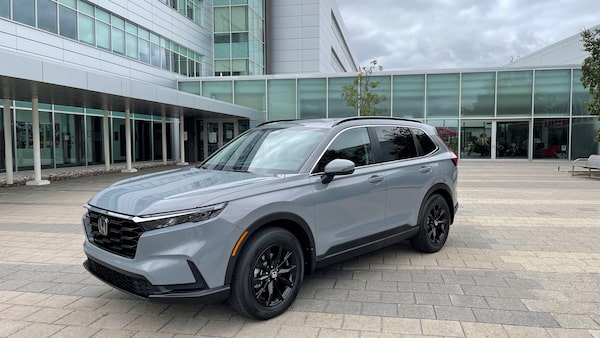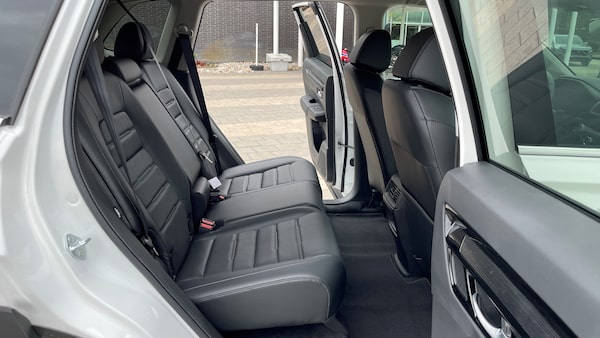
2023 Honda CR-V.Mark Richardson/The Globe and Mail
It’s not often that a vehicle is updated and its fuel consumption is worse, but the new, sixth-generation Honda CR-V compact SUV does just that: the official average fuel consumption for the popular all-wheel drive models is 8.4 litres per 100 kilometres, compared to 8.1 for the previous generation.
It’s not a big deal and your mileage will vary – probably about an extra tank of fuel every year if driving 20,000 kilometres – but this is an apples-to-apples comparison. Perhaps it’s because the new CR-V is a little larger, with a wheelbase that’s extended four centimetres and with almost seven centimetres added to the overall length. This creates more legroom and cargo space in a cabin that’s been updated throughout.
The engine itself is a re-tweaked version of Honda’s 1.5-litre, four-cylinder powertrain. Its turbocharger is rejigged to hold peak power over a greater range, and to top out its torque 300 revolutions per minute earlier, at just 1,700, which it holds all the way to 5,000. You’ll probably never notice.
Of course, the big news for the CR-V is that it will now be sold with an optional hybrid motor, which will save a lot more fuel than the conventional engine. In the city, its rating is 6.0 litres per 100 kilometres, while it has an official average consumption of 6.4. Honda expects the hybrid version will account for half of all CR-V sales in the near future, so maybe that’s where it’s focusing its attention.
The hybrid will add power (up to 204 horsepower, with 247 pounds-feet of torque) and cost. The most basic CR-V starts at $36,740, while the hybrid will, for now, only be available in the top trim with all the bells and whistles for $50,840.

The Honda CR-V has 190 horsepower, but slightly worse fuel consumption than the previous model.Mark Richardson/The Globe and Mail
We’ll be driving the CR-V Hybrid next month, so for this review, we’ll focus on the conventionally powered models.
I took the new CR-V on a short round trip to its birthplace in Alliston, Ont., where all CR-Vs sold in Canada will be made. There are three more Honda plants in the U.S. that will build CR-Vs to meet demand, but Canada is the main plant and will be exporting plenty of them, too.
The 150-kilometre drive was a combination of smooth highway, winding backroads, choppy asphalt and loose gravel. The ride was noticeably quieter under all conditions than I recall in older CR-Vs. It was solid on the road, too, perhaps thanks to having an extra centimetre in width but also owing to a stiffer body and subframes for the front and rear suspension.
What I really noticed was the superb visibility behind the wheel. The A-pillars that hold the windshield in place are moved back almost 12 centimetres, as well as more than seven centimetres out and almost four centimetres down. The side mirrors are now mounted on the doors instead of the base of the pillars and the whole effect was similar to watching an IMAX movie play out on the other side of the windows. Frankly, I’ll trade that tank of gas for the better visibility any day.

The grille is now larger with shallower headlights.Mark Richardson/The Globe and Mail
Tech specs
2023 Honda CR-V
- Base price/as tested: $34,790 / $43,390
- Engine: 1.5-litre turbocharged inline-four; 190 horsepower, 179 lb.-ft. or torque
- Transmission/Drive: CVT / Front-wheel drive and All-wheel drive
- Fuel consumption (litres per 100 kilometres): Front-wheel drive: 8.4 City, 7.1 Highway, 7.8 Combined; All-wheel drive: 9.1 City, 7.6 Highway, 8.4 Combined
- Alternatives: Toyota RAV4, Ford Escape, Hyundai Tucson, Chevrolet Equinox, Kia Sportage, Nissan Rogue, Mazda CX-5, Subaru Forester
Looks
The new CR-V doesn’t look all that different from the previous version until you place them side by side. Then you’ll see the larger, two-piece grille and shallower headlights, maybe also the back end that’s tidier than before. The whole effect creates a cleaner look, though good luck spotting your SUV in a crowded shopping mall parking lot.
Interior

The 2023 CR-V has slightly more spacious seats than the previous model.Mark Richardson/The Globe and Mail
The cabin is improved throughout, with comfortable, slightly more spacious seats and an attractive digital instrumentation display at all price points. The central display touchscreen is either seven inches or nine, depending on the trim and it includes a manual knob for volume. The soft-touch materials feel to be of high quality, and everything is just where you would expect it to be.
Performance
For all Honda’s claims of an improved engine and transmission, the power delivery didn’t feel any different from the previous model, and of course, the fuel consumption is not improved. The all-wheel-drive system is updated to allow up to 50 per cent of engine torque to be sent to the rear wheels. The drive mode can be adjusted between Normal, Snow and Economy, but most drivers will probably leave it in Normal. This new CR-V is not slow, but it’s not a sporty vehicle, even in its Sport trim level.
Technology

The central display touchscreen is either seven inches or nine, depending on the trim, and it includes a manual knob for volume.Mark Richardson/The Globe and Mail
All of Honda’s safety technology is provided at all trim levels, including blind spot information. A camera at the front has a 90-degree field of view while a radar sensor has a 120-degree field of view. The CR-V EX-L held well to its lane in those times when I relaxed my hands from the wheel, and tucked in smoothly behind other vehicles while the adaptive cruise control looked after my speed. The system was simpler and more instinctive than I’ve found in other higher-priced vehicles.
Apple CarPlay and Android Auto are standard, as is wireless CarPlay and Auto in the higher trim level. Remote starting and keyless entry are also standard at all trims.
One nice touch is the windshield wipers. The fluid is sprayed from the arms themselves and only on the upswing, which Honda says can save up to 40 per cent of fluid use. That’ll help offset the extra gas, too.
Cargo

The cargo space in the trunk is 34 litres larger, at up to 1,113 litres with the seats folded up.Mark Richardson/The Globe and Mail
There’s more space in a CR-V than there’s ever been. The cargo space behind the rear seats is 34 litres larger, at up to 1,113 litres, and when those seats are folded down (but not quite flat), the total space expands to 2,166 litres. In the front, the storage under the centre armrest console is large enough to hold a full-sized Kleenex box, at nine litres.
The verdict
The new CR-V offers everything drivers could want in an affordable compact SUV. It’s too bad the fuel consumption is not improved, but other advancements help make up for that, and the arrival of the hybrid will be a welcome addition.
Shopping for a new car? Check out the new Globe Drive Build and Price Tool to see the latest discounts, rebates and rates on new cars, trucks and SUVs. Click here to get your price.
 Mark Richardson
Mark Richardson